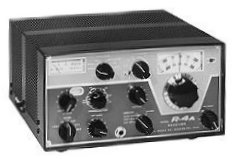
DRAKE R4A RECEIVER
It is rare but fuses do fail for no apparent reason if they are really old. However, before trying a new fuse it would be good to check a few things.
With the power off and the radio unplugged run through the resistance check chart . Any value off by more than 20 percent may indicate a problem, but probably not serious enough to blow fuses. Check the resistance to ground on the 160vdc, 150vdc, and bias.
If the problem occured right after you worked on the radio, look for shorts that may have occured when a bare bus wire was disturbed. Drake used lots of bare component leads for connection to the vertically mounted component modules. It is easy to push these bare wires into contact with other wires and components. That could cause shorts that might blow fuses. It could also cause other problems.
Check the electrolytic filter capacitors. A check with an ohm meter is not conlusive but if it results in a very low reading with no rise to a higher value, the electroytic is most likely bad.
Ohm meters apply a very low battery voltage to the circuit being tested. The electrolytic may appear fine under such low voltage but fail intermittantly when full voltage is applied.
In most cases, a fuse blowing problem is due to dead or dying electrolytics. A bad electrolytic may only be intermittant but it puts a strain on the rectifiers and transformer when it shorts. If you solve the problem by installing a larger fuse, you may loose the rectifiers and even smoke the transformer.
Bad electrolytics need to be removed and replaced with good electrolytics. The old trick of paralleling a good electrolytic across a bad one to reduce hum still allows the old part to cause problems.
While you are replacing the electrolytics, you may also want to replace the silicon rectifiers, just to make sure. A faulty rectifier can damage a new electrolytic. The rectifiers that Drake used are poor devices when compared to new devices. The 1N4xxx series of rectifiers work well as replacements. The 1N54xx series is an even better choice but a bit of overkill.
When there is a problem, tube replacement is usually the first thing done by the inexperienced. Unless the filament does not light up, tube failure is the least likely cause of any problem. My 30 year old radio is still running on its original set of tubes.
Tubes do become weaker with age, but unless that causes a noticable reduction in sensitivity or volume, a new tube will not help much. Then there is always the problem of deciding which of the tubes is weak enough to deserve replacement. A tube tester can be of help here, but you can also find weak ones by just following the voltage chart.
If the distortion is being caused by a hum, replace the electrolytic filter capacitors and perhaps the silicon rectifiers as well. Other causes of distortion can orginate anywhere in the radio. Don't just suspect the audio stages. Distortion, anywhere in the radio will end up coming out of the speaker.
The easiest way of tracing the source of the distortion is to use a general coverage receiver. Tune it to the first IF frequency and use a small capacitor to couple that signal to the antenna input of the general coverage receiver. Check the second IF frequency too. Check the input and output of each stage until you determine where the distortion originates.
-
HOME
OFF TOPIC BLOG
Amplifiers, audio
Amplifiers, RF
Antennas
Boatanchors
CW Keys
DRAKE radios
Equipment for Sale
Ham Radio Misc
Parts for Sale